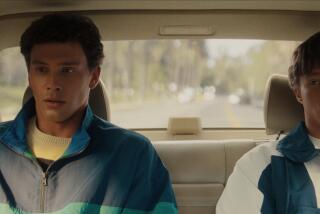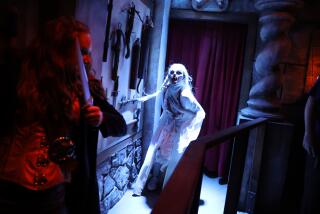Monster concept
When the unusual teaser trailer for “Cloverfield” first appeared unexpectedly before last summer’s blockbuster “Transformers,” it set off a wave of interest verging on hysteria. The clip featured what looked like home-video footage of a New York City house party suddenly erupting into total chaos -- earth-shaking explosions followed by the decapitated head of the Statue of Liberty crashing down the street as stunned onlookers whipped out their camera-phones.
Hastily posted on the Internet, the trailer was soon being dissected with a fever perhaps not seen since the landmark buildup to 1999’s “The Blair Witch Project,” as fans began concocting wild theories about what caused the destruction (a humongous monster), what happens (it goes ballistic on Manhattan) and how much would viewers ultimately get to see (plenty).
But the surprise and secrecy were one component of the inventive film, which opens Friday. While the teaser left potential viewers salivating for more, the most concrete piece of information it provided was that the film came from producer J.J. Abrams, best known for television shows such as the cerebral “Lost,” the action-filled “Alias” and the wistfully romantic “Felicity.”
“Cloverfield” originated with Abrams wanting to reenergize the monster movie, to bring into the 21st century the creepy-fun flicks he had enjoyed as boy; not the charnel-house blood baths of current horror films but rather such enigmatic thrillers as Ridley Scott’s “Alien,” David Cronenberg’s “The Fly” and John Carpenter’s “The Thing” -- movies that surpassed any supposed limitations of the genre.
“I loved monster movies when I was a kid,” Abrams said recently, “and I had not seen a monster movie since then that made me feel anything, where I got that rush. I just desperately wanted to have that sensation.”
With both an idea for the story and a concept for how to shoot the film, Abrams and his producing partner Bryan Burk enlisted writer Drew Goddard (TV’s “Buffy the Vampire Slayer”), who was working with Abrams on “Lost.” Eventually Abrams would also draft Matt Reeves, a childhood friend as well as a co-creator of “Felicity,” to direct. The film’s $25-million budget was financed by Paramount Pictures, for whom Abrams had directed “Mission: Impossible III” and is directing “Star Trek.”
Reeves had previously directed the feature film “The Pallbearer” with David Schwimmer and Gwyneth Paltrow -- not the most immediate calling card for a Monster-Eats-Manhattan picture. “They came to me because what they really wanted was a sense of intimacy and character and realism,” said Reeves. “The thing that ended up being different about this film is the concept of having it be this Handycam story where everything is supposed to be told as if it’s found footage. The whole movie, even though it’s this epic-sized story, it’s shot and done in an intimate manner. So it’s this kind of realistic portrayal of an absolutely outlandish idea.”
The secrecy surrounding the project extended to the casting process as well. The team behind “Cloverfield” hired a group of relatively unknown actors, making the true star of the film not just the monster but also the mystery, which is slowly revealed in the shaky, post-YouTube, faux-found-footage style in which the film was shot. Though the story is supposedly all captured on a single camera, in reality a variety of cameras were used, from top-of-the line professional gear used to seamlessly blend with digital effects to consumer-grade footage shot by the actors themselves
In many ways the story line of “Cloverfield” perfectly joins the conceits of Abrams’ past work -- a shotgun wedding of the puzzles of “Lost” with the yearning of “Felicity.” The film opens with a group of twentysomething New Yorkers gathering for a farewell party as one of their circle departs for a new job in Japan. Romantic entanglements are quickly established, all seen from the perspective of a video camera carried by a hapless character named Hud.
Once the destruction starts, the party empties into the street and the protagonists are plunged headlong into a nightmarish odyssey trying to escape the city. Hud dutifully captures it all on video, driven by the contemporary urge to self-document and a strange need to eke out some control over what’s happening around him.
It is exactly this unlikely mix of the big-shock thrills of a Hollywood action movie and the small-scale interactions of a youth-oriented drama that give “Cloverfield” its charge. Rather than focusing on the attempts to battle the monster, the film settles in with the individual dramas of those caught up in its destructive wake.
According to Lizzy Caplan, who plays the wise-cracking Marlena, the initial audition was a scene that led her to believe the project would be like a film version of “Felicity,” full of heartfelt conversations and lovelorn moments. She was surprised when a callback audition consisted of a frantic action scene that turned out to be from an episode of “Alias.” “Only after being offered the part did we hear it was a monster movie, and only after signing on did we get to read the script,” said Caplan.
Twenty-six-year-old T.J. Miller makes his movie debut as the endearingly beleaguered Hud, who is head over heels for Marlena. Since his character is holding the camera for essentially the entire movie -- and Miller himself often served as camera operator while performing -- he is actually seen for only a few moments. Yet Hud, in directing the viewer’s point of view while also providing a running commentary to the action, is an indelible character. “The audience becomes unified with Hud,” said Miller. “He’s not a character that they watch, he’s a character that they sort of are.”
“The point of view was so restricted, it felt really fresh,” explained Reeves of the film’s unique perspective and format. “It was one of the things that attracted me [to this project]. You are with this group of people and then this event happens and they do their best to understand it and survive it, and that’s all they know.”
The original Japanese version of “Godzilla,” arguably the precursor of the modern, urban monster movie, has always been seen as a direct extension of the Atomic Age anxiety over the bombings of Hiroshima and Nagasaki.
Among the imagery used in “Cloverfield” are collapsing skyscrapers, great clouds of dust and swirling drifts of paper that directly reference the attacks of Sept. 11, 2001. In the hands of Abrams, Reeves and Co., the monster movie remains a repository for the collective unease felt in the wake of a national tragedy.
“ ‘Cloverfield’ is meant to explore the very real and obvious fears we are all living with everyday,” said Abrams, “to let the audience have the experience but in a much more safe and manageable way. . . .
“I believe there are a whole lot of people who want to have that kind of catharsis and who don’t necessarily want to see documentaries about the very issues they are grappling with internally.”
“In a way, what ‘Cloverfield’ does,” said Reeves, “is it puts a name on the unthinkable.”
More to Read
Only good movies
Get the Indie Focus newsletter, Mark Olsen's weekly guide to the world of cinema.
You may occasionally receive promotional content from the Los Angeles Times.











